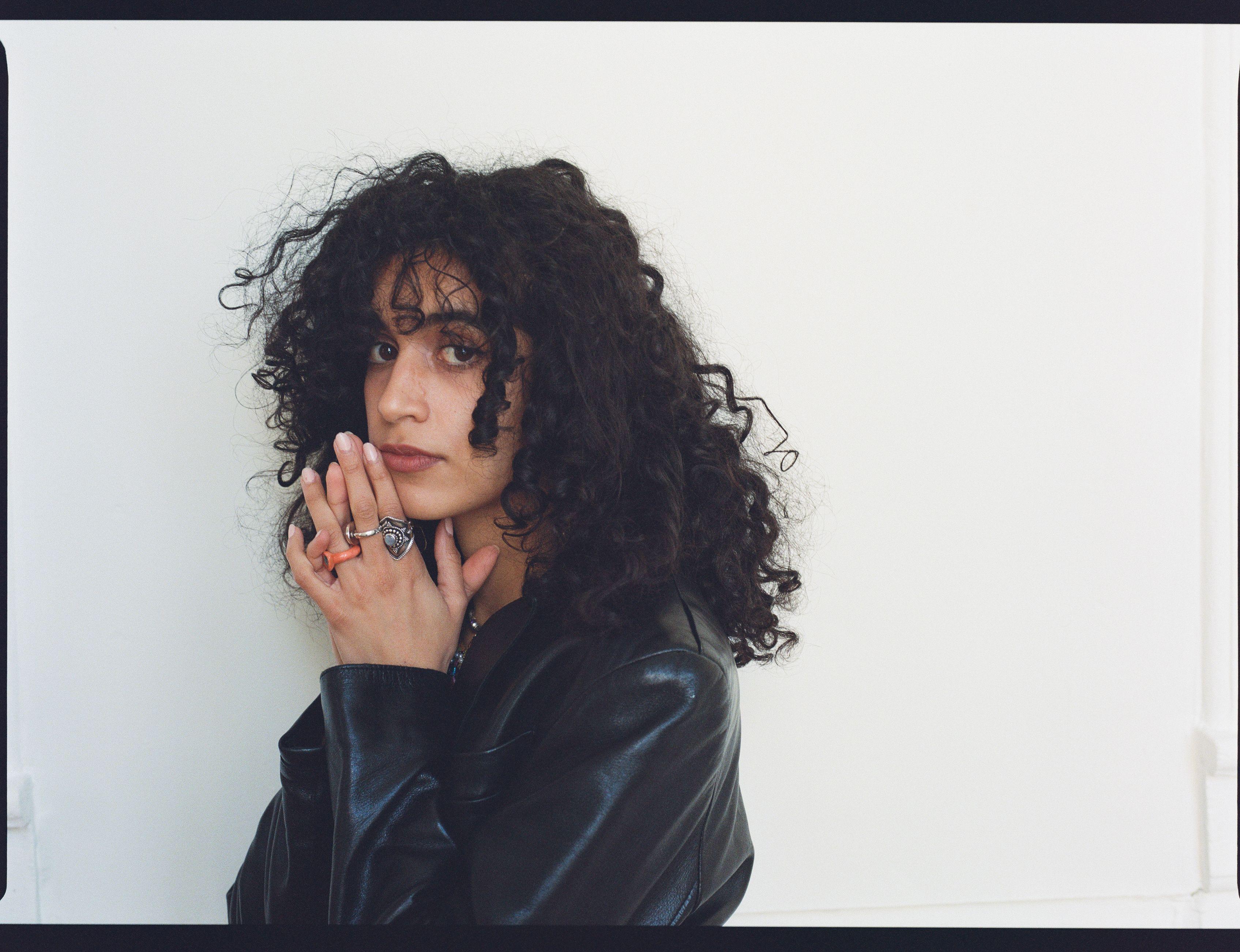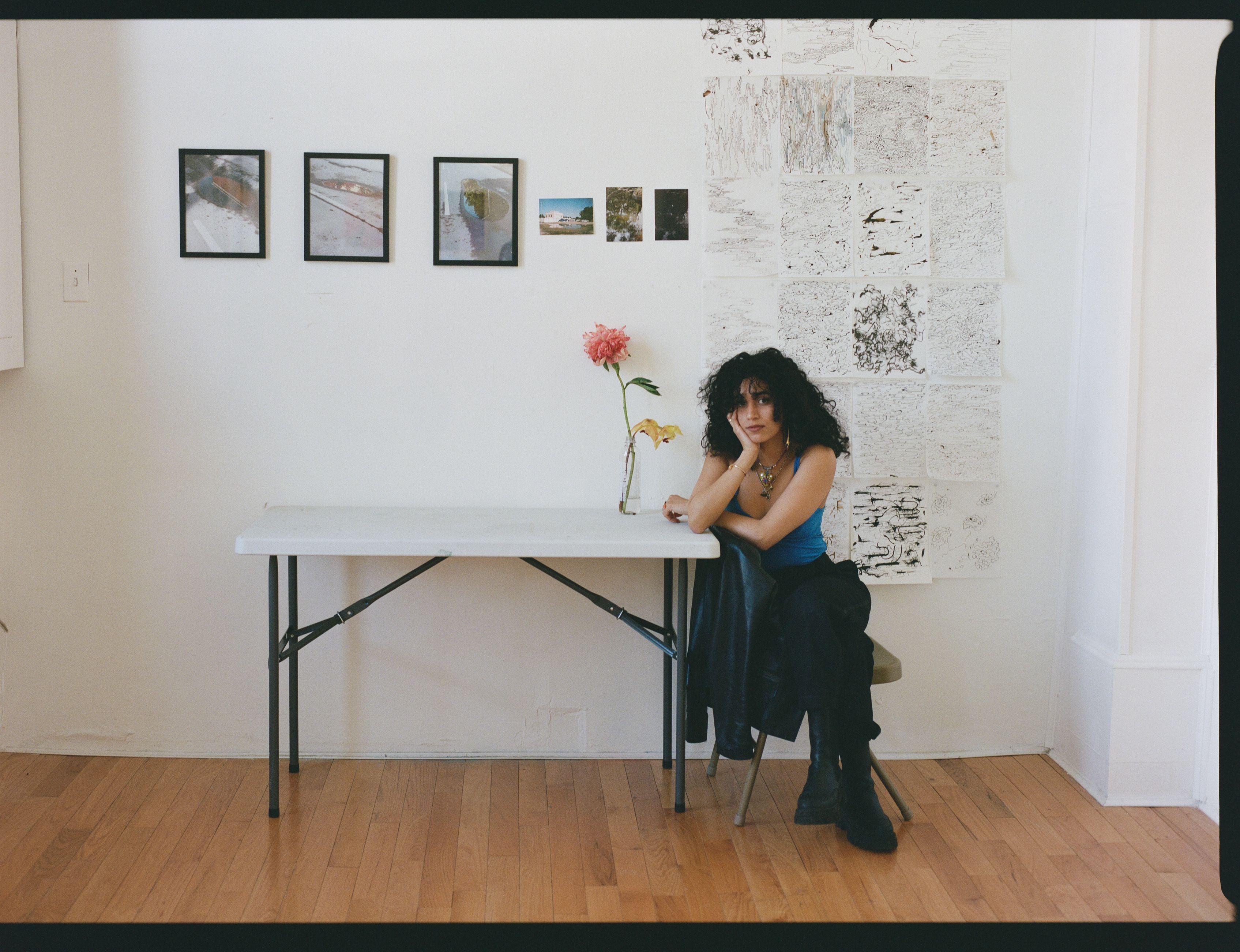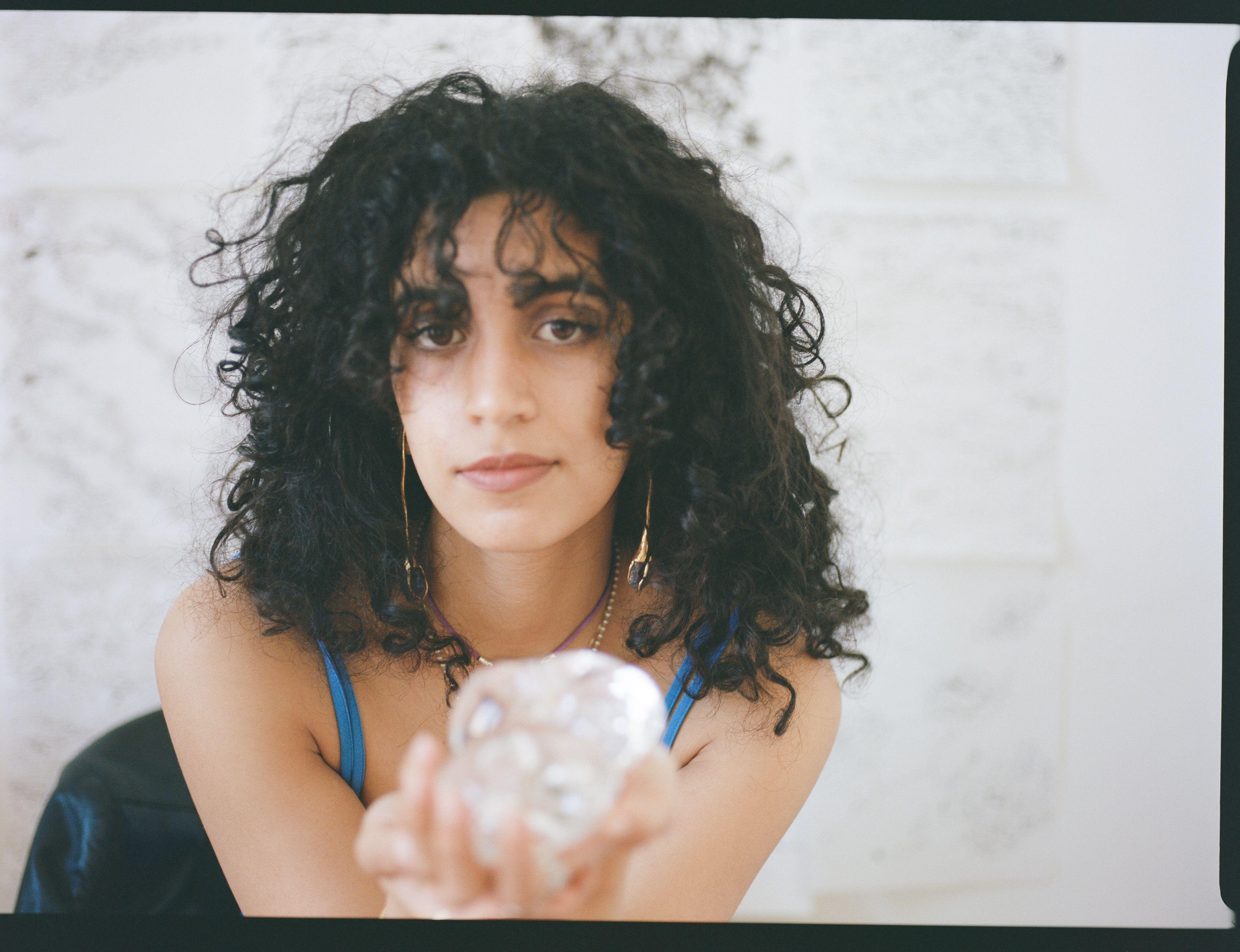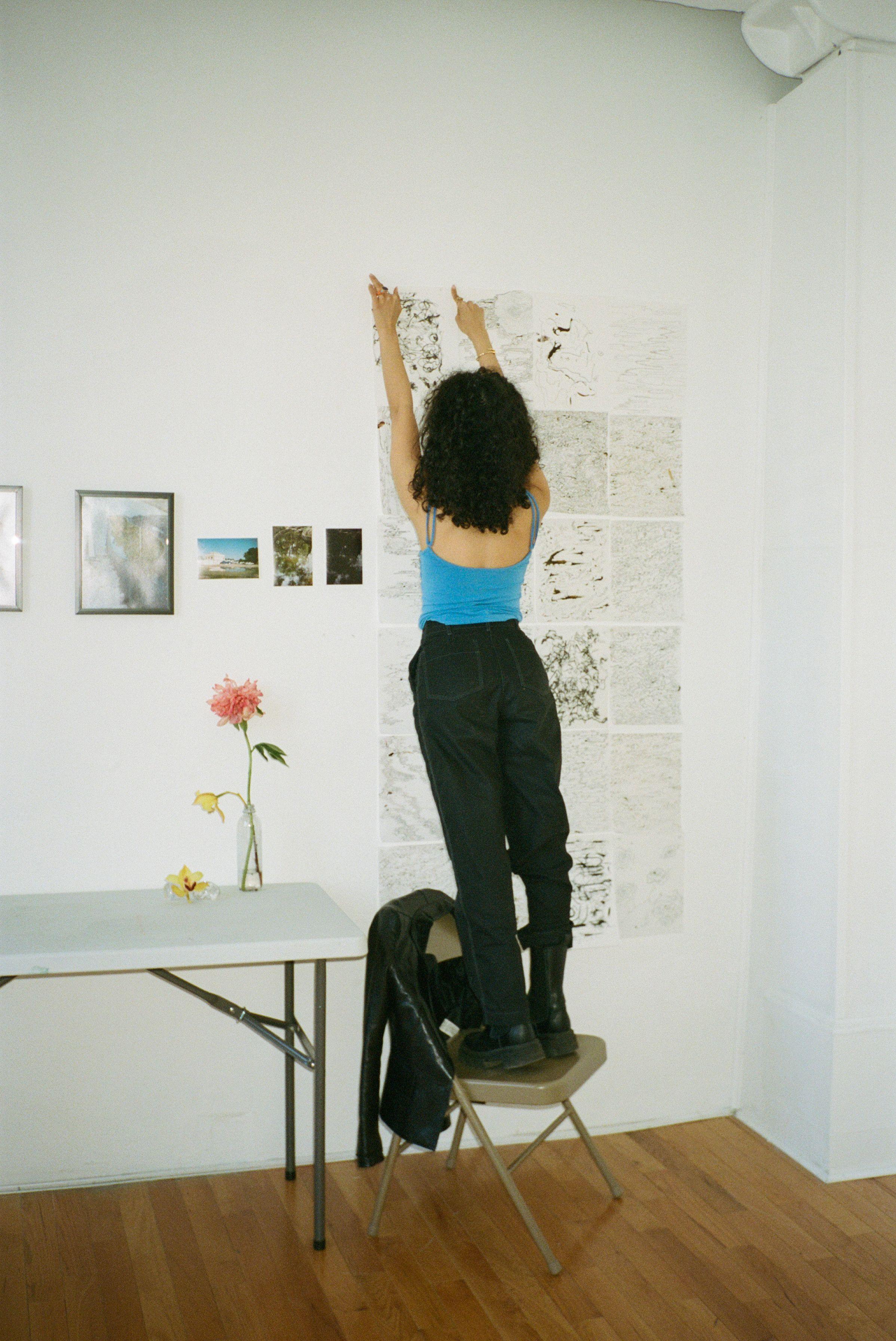
IN CONVERSATION WITH
Mashael Alsaie
Arab mythology, feminism, and New York City.
Born and raised in Bahrain, a tiny island country in the middle of the Persian Gulf, Mashael Alsaie is a multifaceted artist with a particular interest in feminism, Middle Eastern mythology, and the intersection of the two. Minute in stature, Mashael is soft-spoken and eloquent; she could very well be the protagonist of one of the mythical tales she draws inspiration from. Delicate yet confident, her aura is pure, candid like a beam of light in the early morning; the type of sunray that gently wakes you up at 7 AM on a late Spring day. Her energy is calming, comforting almost. She’s the type of friend you’d want to have on speed dial for a bad day.
If she knows you well enough, her text messages will start with “my love” and she won’t be afraid of letting you know when you are on her mind. Innately welcoming, she will always extend an invite to join whatever activity she has planned for her day off, whether it’s a walk at the Brooklyn Botanical Garden on a breezy Sunday afternoon or a pre-dinner sushi-making class. She’s chameleonic in all aspects of her life.
When her hair is slicked back in a low bun and her perfectly-shaped lips painted in Syrah red, it’s not hard to imagine Mashael as the host of highly intellectual, weekly symposiums on art, literature, and culture. When her hair is down, curly, and voluminous, it’s easy to picture her in the studio amid creative chaos, experimenting with darkroom chemicals, drafting ideas for a short film, or directing portrait sessions with her uber-cool circle of friends.
Before coming around to proudly wear the title of “visual artist” on her sleeve, Mashael made use of the BA in Urban Design she got from UC Berkeley by working in real estate in Dubai, specifically taking care of Dubai Design District, from 2017 to 2019. While the corporate essence of the job taught her how to navigate tangly formal spaces, the role was too constrictive and not creative enough. Compelled to let her brain juices flow, she continued experimenting with film photography, focusing her lens on female Arab narratives and spatial politics.
Quick in refining her technique, her dreamy desert landscapes and female-led visual essays began sparking the interest of art institutions in the Gulf. Soon, her work could be found amongst other fellow artists on the walls of galleries worldwide.
In 2019, exhausted by the limited bandwidth granted by the Emirates and her corporate job, Mashael enrolled in a Master's program in Film, Photography, and Arab Feminist Narratives at the NYU Gallatin School of Individualized Study, packed her bags, and moved to New York City.
Interested in learning more about why she chose New York and how the city has shaped her practice, we spent a lunch break together a few blocks away from Baxter St Camera Club—where, at the time of writing, she held the title of Gallery Manager—in the backyard of Saturdays, sipping coffee and unpacking her art.
Naomi Accardi
Why New York?
Mashael Alsaie
I felt like I wanted to expand. I didn't know in what shape and what direction or how. And for some reason, I was drawn to chaos. I needed to do something different, and that meant going somewhere that would pull the rug from under me. I don’t know how to explain it clearly, but I just wanted to feel really shaken at the core.
Naomi Accardi
Then I guess you chose the right destination. “Chaos” is the best dish on the menu here.
Mashael Alsaie
I definitely think I succeeded at being shook. Before coming here, I had never considered myself an artist. Many things didn’t make it to the screen, like poetry and writing, and the process of getting to know what I could actually achieve was slow. But now, I am able to recognize that what I do is art and it’s genre-bending. Before moving, I tended toward certain subjects aesthetically but I only got the chance to step back and question these pulsions when I uprooted myself. I think New York really teaches you that it’s up to you. It’s you alone. You can’t take things personally, and no one is going to hold your hand. So if you are going to do something and have the privilege of being labeled as an artist, you have to dig into what you are trying to say and pull out that message. New York pushed me to analyze my audience.
Naomi Accardi
It forced you to put things into perspective.
Mashael Alsaie
Right. And a huge part of what I engage with is mythology from my birthplace. And now, I am producing in a place that isn’t where I am from, nor it will ever be where I am from, so choosing to do so in a foreign city was and is a double-edged sword. I felt like I could be productive here but at the same time, I felt very insecure and alone in the making process, which as a consequence gave me a lot more time to reflect and write. And those are the times when my new mediums start to develop and integrate into my practice at large.
Naomi Accardi
Stepping out of your comfort zone, especially after you carve a niche for yourself, can be quite alienating. I can imagine that’s even harder when so much of your identity as an artist and inspiration is interlinked with your home. How were you able to overcome the loneliness and use your references as a pivot?
Mashael Alsaie
I was part of two artist residencies and I met a plethora of other Arabs that made me realize I am not really alone. My people are ubiquitous. There are so many of us in different positions, whether it’s another art gallery, a friend of a friend who’s also Palestinian, and showing at the Moma. I realized that there are so many others like me here. It’s heart-warming but it also shifted gears in my brain from asking who can make space for me to a need to make my own space and make room for my people.

Naomi Accardi
That’s a beautiful realization to have. Making space for others is a noble thing and it doesn’t receive the type of praise it deserves. Did you manage to find your way of opening the ground for others? And in turn, has it helped you feel more connected?
Mashael Alsaie
I like to host, so I began thinking about how I create intentionality with how I host. I am not at a stage where I just want to go out nor I find passive enjoyment fulfilling. I started asking myself how can I connect with people intentionally, through common interest? That’s what made this place feel like a village for me.
Naomi Accardi
I went to Banat Al Hara, a group show you were part of with other Arab female artists during Ramadan in April of 2023. Of course it was joyful because of the holy essence of the moment but the atmosphere was so homely. Instead of showing the work of different artists in a sterile room as we often see, it was a full-on celebration. There was food, drinks, music, pillows on the food, people mingling. It felt like I entered somebody’s living room but with eclectic, beautiful art on the walls. It felt like a slice of the Middle East in the city and it was interesting to see how one can create their own pocket of community in a city like this.
Mashael Alsaie
And it’s very hard! Creating a community is a lot of work. I was having this conversation with someone recently. We were discussing the different sorts of Arab “parties” in the city. And it feels very strange and exciting at the same time because, on the one hand, I don’t have a choice. I am Arab everywhere I go, you know what I mean? And it feels almost pseudo-performative to make that, like, be a point. I enjoy these spaces because I enjoy listening to music but building community isn’t about the perception of it, it’s about truly building something. Are we engaging in some really interesting conversations? And I think what’s so fucking cool about this city is the fact that you never know what type of conversation you are going to have.
Naomi Accardi
Or with whom.
Mashael Alsaie
It’s good and bad. I have had shitty conversations here, too, you know. But I guess that's what is so addictive about being here. If you are curious, there are so many places and people to be curious about.

Naomi Accardi
New York is such a transitional place too. You can meet someone who’s only here for two weeks and feels right at home, or you can meet somebody who’s been here for twenty years and has finally decided to move on. You meet so many different personalities and this element feels so unique to New York. Like, we met in Dubai, and to an extent, Dubai is also very diverse, but it’s so hard to meet people and mingle with individuals who are not part of your same community or background. Luckily, I was able to create my own circle of friends, like yourself, that were really nice and the only thing we had in common was a shared love for the arts and the fact that we were young creatives.
Mashael Alsaie
How glorious is that? The love of being young and creative.
Naomi Accardi
It was indeed nice, but at the same time alienating. And I believe that the structure of the city has a lot to do with the way people interact. You can’t just walk outside and meet people, you have to make an appointment to see each other. Very different from here where you can just hop on the subway and you never know who you are going to bump into. You can find some people that are Arab like yourself or Italian like me, or people with totally different stories but everybody just blends in so seamlessly.
Mashael Alsaie
At the same time you meet so many people that it’s very up to you to be open and learn about them. Something I have been doing since Dubai, and then moving here, and really satisfies my need to get through people is the portrait sessions that I host. They come from a place of curiosity, where I want to capture this person and their energy, how they see themselves, and how they want to be seen. And then that becomes such an intuitive process. Because I definitely felt like I tried to be as empathetic and give the space for that person as much as I can while being sensitive to their energy. That’s how I was able to get into a really great group of people here and use it to my advantage, in the sense that, oh, I really like this person and I would love to photograph them and it becomes a beautiful exchange. This process has taught me to be present in photography and think about portraiture as a moment in time of this person.
Naomi Accardi
That’s a beautiful way to grow in your art and as a person simultaneously.
Mashael Alsaie
I have a friend, Ida, whom I have known since college and I have taken a portrait of her almost every year since we met. And it’s been so amazing to look back at this series because it’s become an archive of moments in time with this person. And we can be very vulnerable with each other and it becomes a conversation, a push and pull. She's very sensitive to the poetry of image-making. She's a poet herself. Those sorts of portrait conversations are so delicious to me because they're energetic. And sometimes they're one hour, sometimes they are longer and sometimes it becomes such a great way to connect with someone.

Naomi Accardi
Wow. I guess it also becomes an exercise for you to understand where to steer your work next and find meaning in what you do as well.
Mashael Alsaie
With time, the photos start to carry a similar language. I noticed what is my lens. It’s the common through. The light, the framing... Suddenly, I am like wow, I see patterns in my work. And it’s funny, because I have this discerning eye, again because I am here and often working in a solo space, I have started to decipher and pinpoint how to read my images as a collection or as an archive rather than something to acknowledge and then put in a dropbox folder for a future meeting.
Naomi Accardi
We can call it an artistic epiphany!
Mashael Alsaie
I started working with glass, that’s the medium I am exploring the most right now, and by no means I am an expert. But I love being an amateur in a medium class because I get to ask really stupid questions. I found that the glass community is very friendly and supportive. Inherently, glassmaking is a very communal process because you cannot do anything by yourself. I took a workshop with this amazing glassblower, Alex, and then we started working together and I really fell in love with this material and drowned in the poetry of something that was sand and turned into glass, and then again it’s a substance that mimics water. And it came full circle for me.
Naomi Accardi
You transitioned from photography to film and now glass. Is the next step putting them all together?
Mashael Alsaie
Why not! It all comes from introspective inquiry, what am I trying to see? And then, what’s the medium that can carry weight? What I found with photography is that a lot of times I couldn’t enter the story and really express the things I was trying to get out. Photography couldn’t carry that burden. I started feeling like I had to liberate the photograph. And that’s where film becomes more liminal. It allows you to work with timing and all the other stuff we were talking about. And with glass, it became a liberation from narrative in itself.
Naomi Accardi
That’s an interesting thought. What do you mean?
Mashael Alsaie
I was part of a show last May in Switzerland, the first time showing my glass prototypes, and it was also the first time there was no visible text on the wall explaining what these pieces represented. And they were these tears that encapsulated Frankincense in glass and the story behind that is this mythology I had encountered in Bahrain, where a woman in a palm tree grove gets approached by a man, and some sort of sexual violence or physical violence happens. She begins to weep and her tears and her body turn into a spring. And that spring is something that I lived beside my entire life when I was growing up. But I never had access to the physical site. And then, when I heard about this story, I was just kind of like...This is so crazy because all these layers of meaning are collapsing into this place where it's unifying land, body politics...the idea of resource loss and extraction, and the fact that the site is called Ain Adhari. The name comes from the root word for Virgin, to even further hone in this idea of the feminized land.
Naomi Accardi
I can see why you chose to study Urban Design. Space really has you in a chokehold. I love how you took the story and synthesize it into a glass creation.
Mashael Alsaie
The glass pieces themselves were my imagination of the tears that this woman cried and frankincense because frankincense comes out of the tree looking like tears. It's like the marriage of the spiritual and the natural, the physical and the man made in this glass thing that was so violent in the making process and then so quiet in the exhibition. And that’s what I want to make. I want to make something that feels like I have taken the journey of the material and thought about its transformation, all the way to the moment when it’s shared. And that’s when intentionality comes back into the picture.
Naomi Accardi
Last year I worked with a Murano glass company in Venice and found out about how wide and international the glass community is. It's a very meticulous form of art. It's fascinating how fragile yet versatile this material is.
Mashael Alsaie
At the moment, I am thinking about reflections in the glass and the materiality of water.
Naomi Accardi
I love the way these two elements interact with each other, you know, the sound you can produce by adding or removing water from a glass.
Mashael Alsaie
The density, yeah! There are all of these moments in which the interaction between glass and its environment brings new meaning. I was reflecting a lot on the story, the myth, like what happened to the man? Did he drown in the water? Not to recenter a male narrative but how can I think about the drowning? This site, the oasis, keeps on giving! I am the type of person who likes to collect data and then find new ways of metabolizing it. But that process can be infinite. To go back to the conversation about New York, I feel like this city gives me discipline. It keeps me accountable for managing my time.
Naomi Accardi
And now you are working with the gallery. What’s it like to go from being an outsider artist to managing the work of others? What have you learned?
Mashael Alsaie
I have the privilege of working with people who are just superstars, right...like, learning about people's processes so intimately, it isn't just a studio visit. I am with them for an extended period. The place where I work, Baxter St. Camera Club is so mission-focused. They try to work on professional development with these artists, it’s at the forefront of what they do. There are several touchpoints where we interact with the artist. There are curatorial open calls too, and so, even from an exposure point of view, I am seeing so much interesting work that I don’t doubt it’s going to benefit my practice itself.
Naomi Accardi
Your last job in Dubai was totally different.
Mashael Alsaie
Oh yeah, definitely a new venture. In Dubai, I was working in real estate for Dubai Design District. And that job taught me a lot about professionalism and how to deal with very sticky situations.
Naomi Accardi
That, but also the fact that it was essentially a government-mandated company and a neighborhood that was completely manufactured from scratch to appeal to a certain type of tenant. It probably didn’t allow for a lot of creativity or daydreaming.
Mashael Alsaie
What attracted me to that job, following my degree in Urban Design, was exactly the fact that it was an insular space, and in a weird way, it works. The city was catering to a demographic and creating a space for them. And then you come to a place like New York and it’s the opposite. This type of urban planning doesn’t exist.
Naomi Accardi
The process here is reversed. It’s the people who decide which area suits them best and turn it into a community.
Mashael Alsaie
It’s such an interesting topic. It really comes down to the fact that New York is very walkable and there’s this constant surprise element. But at the same time, New York is very self-conscious. I know you were just in the Lower East Side and like, Dime Square is such an interesting space. It’s very hyperconscious.
Naomi Accardi
Also how it came to be Dimes Square!
Mashael Alsaie
You know, on any given warm day, I’ll sit at Parcel and I think, wow, it’s such a lovely day outside. I catch myself in these moments of “treading the space” that are just a product of late capitalism. But at the same time, I am engaging in it. The same irony exists in Dubai.
Naomi Accardi
We could talk about this forever, but I think it’s time for you to go back to work. I hijacked you for too long. Last question, you have evolved so much as an artist since first moving to NYC for your Masters. Where do you see your journey as an artist will take you?
Mashael Alsaie
There’s a side of me that is very much into research and supporting artists, and eventually, down the line, I would love to run a residency or teach. It’s not all about centering my practice but about other people. I am not sure what shape it’s going to take but I am learning to take it one step at a time.
Since having this conversation, Mashael has quit her job at Baxter St. Camera Club and relocated to Saudi Arabia where she currently takes care of Public Programs for the Diriyah Biennale Foundation.